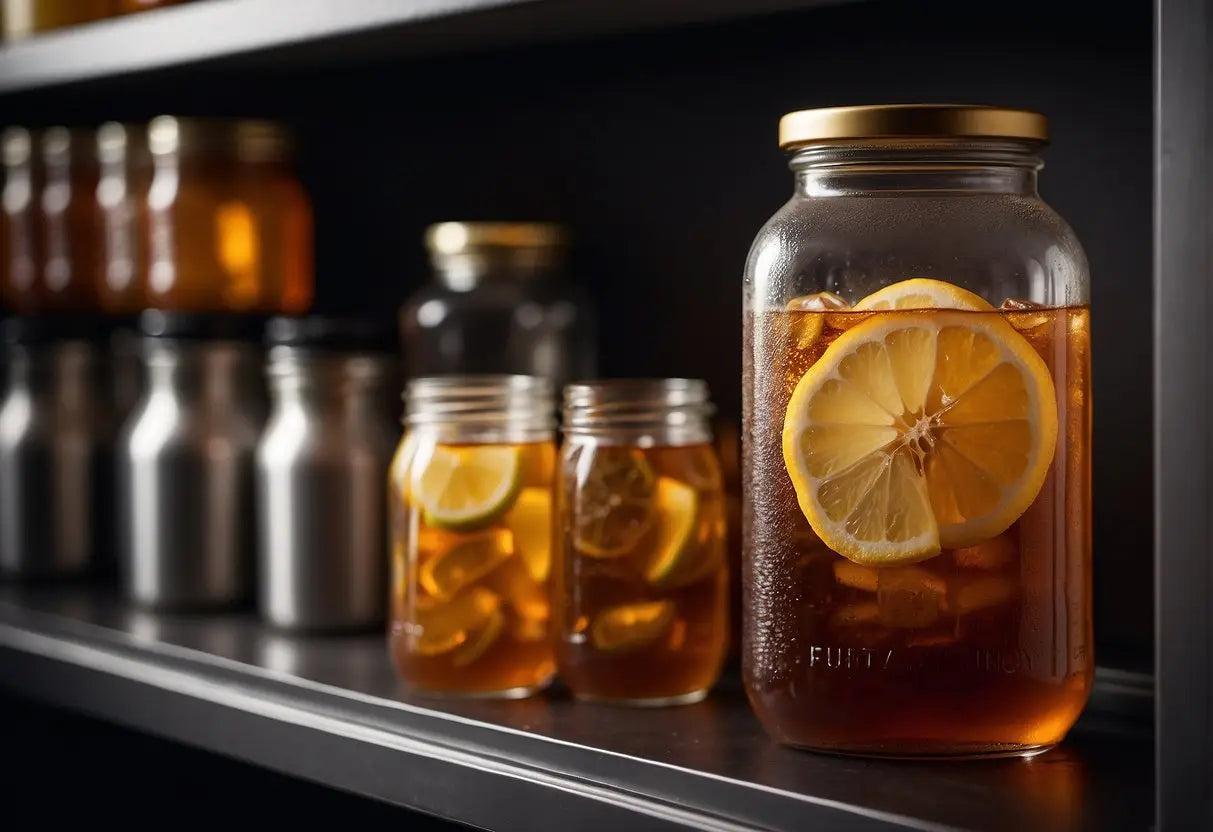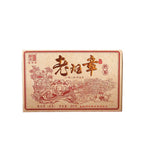How Long is Iced Tea Good for
Shop our Pu Erh Tea collections!
When considering how long iced tea is good for, it's essential to know that the shelf life of your iced tea can vary significantly. Different factors contribute to the longevity of your iced tea, including the type of tea, storage conditions, and whether it is store-bought or homemade.
Store-bought Iced Tea:
Bestsellers
Typically, commercial iced tea comes with a best-by date which can be a helpful indicator, but unopened bottles or cans can remain safe to drink beyond this date if stored properly. Once opened, store them in the refrigerator and consume within 7-10 days to ensure freshness and safety.
Homemade Iced Tea:
For homemade iced tea, the timeline is shorter. Without preservatives, it’s safer to consume your homemade iced tea within 1-2 days, particularly if you’ve added fruit or sugar, as these can expedite bacterial growth.
Keep these key points in mind:
- Refrigerate your iced tea at below 40°F (4°C) to prevent bacterial growth.
- Use clean, airtight containers to extend freshness.
- Avoid leaving iced tea at room temperature for more than 8 hours.
Be vigilant about any changes in taste, smell, or appearance—cloudiness or a sour smell signal that your iced tea should no longer be consumed. Remember, when in doubt, it's safer to dispose of the iced tea than to risk foodborne illness.
By following safe storage practices, you can savor your iced tea while minimizing the risk of spoilage.
Factors Influencing Iced Tea Freshness

The freshness of your iced tea is contingent upon several critical factors, from the way it is stored to the ingredients used. Understanding these can help you ensure your tea remains fresh for as long as possible.
Temperature and Storage Conditions
To maximize freshness, store your iced tea in the refrigerator immediately after cooling. Temperature is crucial – iced tea should be kept at 40°F (4°C) or below to slow bacterial growth. Avoid leaving iced tea at room temperature for more than 8 hours, as this can significantly reduce its shelf life. Storage conditions also matter; always use an airtight container to protect the tea from absorbing other flavors and odors.
Tea Type and Brewing Method
Different tea types and brewing methods can affect how long iced tea stays fresh. Loose-leaf teas or high-quality tea bags typically yield a beverage that is more stable due to lesser processing and fewer impurities. Cold-brewed iced teas also tend to last longer than their hot-brewed counterparts because the brewing process is gentler and less likely to introduce tannins that can affect taste over time.
Presence of Additives and Preservatives
Finally, the presence of additives and preservatives can either extend or reduce the shelf life of your iced tea. Unsweetened tea without any added fruits or herbs will generally stay fresh longer. Conversely, iced teas with natural preservatives like lemon can extend shelf life, whereas sugar and dairy can make the drink perishable faster. Always check for mold or off odors as signs that your iced tea is no longer good to drink.
Proper Storage Practices for Iced Tea

Lao Ban Zhang
Effective storage of iced tea is crucial for maintaining its flavor and freshness. Proper refrigeration and the right container are essential.
Refrigeration Guidelines
For optimal freshness, you should store iced tea in the refrigerator immediately after cooling and continue to keep it refrigerated. Adhere to the following:
- Temperature: Keep your refrigerator at or below 40°F (4°C).
- Shelf-life: Consume homemade iced tea within 3-4 days, and commercial iced tea by the expiration date.
Container Selection
The choice of container can impact the taste and lifespan of your iced tea. Use these tips:
- Material: Glass or food-grade stainless steel are preferable. Avoid plastic, which can harbor flavors and odors.
- Seal: Ensure the container has a tight-sealing lid to block out odors and prevent spills.
- Size: Select a size appropriate for the amount you will drink within a few days to avoid prolonged storage.
Identifying Signs of Spoilage

Awareness of spoilage signs is crucial in determining if your iced tea has gone bad. Look for these key indicators before consumption.
Visual Changes
- Clarity: Check if the iced tea has become cloudy. Presence of cloudiness can suggest bacterial or mold growth.
- Color: Note any discoloration. Iced tea that has darkened or developed an unusual hue may be spoiled.
- Mold: Inspect for visible mold, which may appear as fuzzy spots on the surface or sides of the container.
Odor and Taste Alterations
- Odor: Smell your iced tea. An off or sour odor is a clear sign the beverage should not be consumed.
- Taste: If the odor does not raise suspicion, a small taste can be telling. Do not swallow the tea if it tastes unusual or sour.
Health and Safety Considerations

When consuming iced tea, it's essential to be mindful of its shelf life to prevent foodborne illnesses. Iced tea should be safe to drink if stored properly in the refrigerator for up to 8 hours. After this period, the risk for bacterial growth increases, and you should not consume it.
Storage:
- Refrigerate promptly: Store iced tea in the refrigerator and keep it at a temperature below 40°F (4°C).
- Airtight containers: Use sealed containers to protect the tea from absorbing refrigerator odors.
Preparation:
- Use clean utensils: Ensure that everything used to make the iced tea is sanitized.
- Boil water: Boil water for at least one minute to eliminate bacteria before brewing tea.
Indicators of Spoilage:
- Taste and smell: Spoiled iced tea may have an unusual taste or odor.
- Cloudiness or thickened texture: Visible changes may also indicate spoilage.
- Mold: Any signs of mold mean you should discard the tea immediately.
Note: Despite these general guidelines, use your best judgment and discard any iced tea that seems off, regardless of its storage duration. Always prioritize your health and safety by erring on the side of caution when assessing whether iced tea is still good to drink.
Maximizing Enjoyment and Quality

To ensure your iced tea retains its flavor and safety, it's important to follow certain guidelines. Here's how you can enjoy your iced tea to the fullest without compromising its quality.
Best Practices for Consumption
- Storage: Keep your iced tea in the refrigerator at or below 40°F (4°C).
- Container: Store in a clean, airtight glass container to preserve taste.
- Duration: Consume within 8 hours for best flavor, never exceed 48 hours.
- Sensory Check: Always smell and taste a small amount before drinking fully.
- Hygiene: Use clean utensils to avoid introducing bacteria.
Refreshing versus Discarding
-
Refreshing:
- Addition of Ice: Add ice to maintain chill without diluting flavor for up to 24 hours.
- Avoid Repeated Warming: Repeatedly warming iced tea can degrade its quality.
-
Discarding:
- 48-Hour Rule: Discard any iced tea left in the fridge for over 48 hours.
- Off Odor or Flavor: If the iced tea develops a sour smell or taste, discard immediately.
- Visible Mold: If you see any signs of mold, dispose of the iced tea right away.
Frequently Asked Questions
Iced tea's freshness is vital for both taste and safety. Here's what you need to know about its longevity, from homemade brews to store-bought bottles.
What is the typical shelf life of homemade iced tea in the refrigerator?
You can expect homemade iced tea to remain fresh for about 3 to 4 days in the refrigerator. After this period, you should brew a new batch to ensure optimal flavor and safety.
Can you safely consume iced tea left unrefrigerated overnight?
Iced tea left out at room temperature for more than 8 hours is not recommended for consumption. Bacteria grow rapidly at temperatures between 40°F and 140°F, which can lead to foodborne illness.
How can you tell if your iced tea has spoiled?
Your senses are reliable tools for determining spoilage. If the iced tea develops a sour or off odor, a strange flavor, or a cloudy appearance, it's best to discard it.
Does the shelf life of cold brew tea differ from regular iced tea when stored in the fridge?
Yes, cold brew tea can typically last a bit longer than regular iced tea in the fridge because of its brewing method. This allows it to be stored for up to 5-7 days while retaining its quality.
What factors affect the longevity of iced tea when kept refrigerated?
Factors that impact the longevity of iced tea include the tea's initial temperature, the cleanliness of the brewing and storage containers, and the presence of any additives like fruit or sugar.
Is commercially bottled iced tea, like Lipton, viable for longer periods than homemade iced tea in the fridge?
Commercially bottled iced tea usually has a longer shelf life than homemade iced tea due to preservatives. It can often be stored in the fridge for several weeks once opened, but always check the expiration date and follow the manufacturer’s storage recommendations.
← Older post Newer post →











